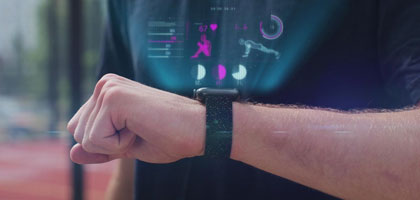- Published on
Wearable Health Monitors The Future of Personal Healthcare
- Authors

- Name
- Adil ABBADI
Introduction
The wearable technology market has witnessed exponential growth in recent years, with health monitors being at the forefront of this revolution. Wearable health monitors have transformed the way we approach personal healthcare, enabling individuals to track their vital signs, monitor chronic conditions, and make data-driven decisions about their well-being. In this article, we'll delve into the benefits, advancements, and potential of wearable health monitors, highlighting their impact on the future of personalized healthcare.

- The Evolution of Wearable Health Monitors
- Advanced Health Analytics and AI-Powered Insights
- Integration with Healthcare Infrastructure
- Challenges and Opportunities
- Conclusion
- The Future of Healthcare Starts Now
The Evolution of Wearable Health Monitors
The first wearable health monitors emerged in the early 2010s, primarily focusing on fitness tracking and basic health metrics. However, these early devices had limited capabilities and accuracy issues. Fast-forward to today, and we've seen a significant leap in technology, leading to the development of advanced wearable health monitors that can track a wide range of health parameters, including:
- Heart rate and rhythm
- Blood oxygen levels
- Blood glucose levels
- Blood pressure
- Body temperature
- Electrodermal activity (EDA)
These advanced sensors enable wearables to provide accurate and meaningful insights into an individual's health, allowing for early detection of potential health issues and enabling proactive measures to prevent illnesses.
# Example code snippet for collecting heart rate data using a wearable device
import heart_rate_monitor
hrm = heart_rate_monitor.HeartRateMonitor()
heart_rate_data = hrm.collect_data()
print("Heart Rate:", heart_rate_data)
Advanced Health Analytics and AI-Powered Insights
Wearable health monitors have transcended beyond mere data collection, incorporating advanced health analytics and AI-powered insights to provide users with actionable recommendations. These sophisticated algorithms can:
- Identify patterns and anomalies in health data
- Detect early warning signs of chronic conditions, such as diabetes and hypertension
- Offer personalized health advice and guidance
- Enable remote monitoring and alerts for healthcare professionals
For instance, some wearables can detect irregular heartbeats, alerting users to potential atrial fibrillation, a common condition that can lead to stroke and heart failure. AI-driven insights can also help users optimize their lifestyle, suggesting tailored exercise regimens, nutrition plans, and stress-reduction techniques.
// Example code snippet for analyzing heart rate variability (HRV) using wearable data
import hr_analytics
hr_data = wearable_device.get_heart_rate_data()
hrv_analysis = hr_analytics.HRVAnalysis(hr_data)
print("HRV Analysis:", hrv_analysis.get_results())
Integration with Healthcare Infrastructure
The seamless integration of wearable health monitors with existing healthcare infrastructure is crucial for realizing the full potential of personalized healthcare. This includes:
- Electronic Health Records (EHRs) integration, enabling healthcare professionals to access accurate and up-to-date patient data
- Telemedicine platforms, facilitating remote consultations and monitoring
- Healthcare apps, providing users with a centralized hub for tracking their health and communicating with healthcare providers
By bridging the gap between wearable health monitors and healthcare infrastructure, we can create a more connected, efficient, and patient-centric healthcare ecosystem.
// Example code snippet for integrating wearable data with EHRs using an API
import healthcare_api
ehr_client = healthcare_api.EHRClient()
wearable_data = wearable_device.get_health_data()
ehr_client.upload_data(wearable_data)
print("Data uploaded to EHR successfully")
Challenges and Opportunities
While wearable health monitors have made significant progress, there are still challenges and opportunities to address, including:
- Ensuring data accuracy and reliability
- Addressing concerns around data privacy and security
- Expanding accessibility and affordability for underserved populations
- Integrating wearable data with emerging technologies, such as augmented reality and artificial intelligence
By acknowledging these challenges and seizing opportunities, we can unlock the full potential of wearable health monitors, paving the way for a more proactive, personalized, and effective healthcare system.
Conclusion
Wearable health monitors have revolutionized the way we approach personal healthcare, offering unparalleled insights into our health and well-being. As technology continues to advance, we can expect even more sophisticated wearables that will empower individuals to take control of their health and enable healthcare professionals to provide more targeted, effective care.
The Future of Healthcare Starts Now
The future of healthcare is wearable, and it's time to take the first step. Invest in your health today by embracing wearable health monitors, and join the journey toward a more personalized, proactive, and effective healthcare system.

